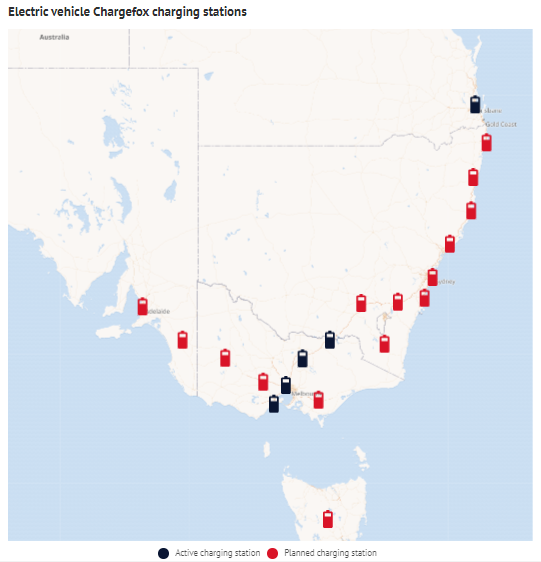Australia’s largest public electric vehicle charging network has announced an ambitious plan to grow its ultra-rapid sites to more than 100, linking up the eastern seaboard in a bid to increase consumer demand.
Chargefox will on Thursday reveal the target locations for 22 sites in the first phase of its fast EV charging network, connecting Adelaide, Melbourne, Sydney and Brisbane – with additional sites in Western Australia and Tasmania – delivering 450 kilometres of range in just 15 minutes.
Sales of electric vehicles have increased this year from 670 electric vehicles in the first half of 2018 to 1277, despite national vehicle sales falling 8.4 per cent in the same timeframe.
The industry predicts consumer uptake will increase throughout the rest of 2019 and into 2020 as model availability increases while prices continue to fall towards parity with fuel cars during the next three years.
The issue was turbo-charged during the federal election campaign as the Morrison government aggressively criticised Labor’s election pledge that half of all new cars sold in 2030 would be electric.
Infrastructure Australia, the government’s independent infrastructure advisor, has called for the fast-tracking of a national charging network to allow for a smooth transition to the electrification of the transport sector – particularly along highways, in regional Australia and in urban centres.
Electric vehicle manufacturers have cited “range anxiety” as a major hurdle in the uptake of the cars in Australia, with a lack of public charging infrastructure holding back EV adoption.
Chargefox has already opened five ultra-rapid stations, including charging stations in Victoria on the Hume Freeway in Euroa and Barnawartha North, near Wodonga.
A further roll out of stations connecting Adelaide, Melbourne, Sydney and Brisbane, powered by renewable energy, including on-site solar, is likely to be completed over the coming year.
Nine sites will be built along the major NSW tourist routes on the east coast including from Gundagai, Goulburn, Sydney, Ballina, Coffs Harbour, Port Macquarie, Karuah, Cooma, and Shell Cove.
Sites in Adelaide and Keith, will attempt to link South Australia to Victoria, with new sites planned for Ballarat, Horsham and Moe.
Every site will have at least two parking bays equipped with 350kW capable Tritium and ABB chargers. Select sites will feature two additional Tritium 50kW chargers.
Chargefox chief executive Marty Andrews said EV charging needed to be “simple, fast and clean” and the new network would lead the way in “making this a reality for all Australians”.
“From our rapid growth over the past two years, we’re learning how drivers in Australia use EVs and are now using those lessons in future planning to grow the network Australians need,” he said.
He said the network would go a long way to solving the eternal “chicken or the egg” problem the industry has faced until now.
“The most difficult problem to solve for electric vehicles so far is the problem of national infrastructure,” he said.
The ultra-rapid charging network is a multimillion-dollar investment by state-based motoring services, private investment and supported with grants from the Australian Renewable Energy Agency and the Victorian government.
The Electric Vehicle Council has been highly critical of government planning for a transition to EVs, with government fleets buying only 4 per cent compared to 63 per cent of sales from business fleets.
A report last month found the low level of government uptake was particularly concerning given the poor performance of vehicle fuel efficiency in government fleets compared to private and business vehicles.
Extracted from The Sydney Morning Herald
